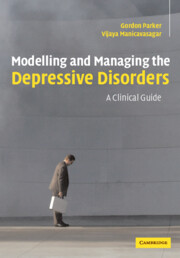Book contents
- Frontmatter
- Contents
- Acknowledgements
- Introduction
- Part I The current model for depressive disorders and its impact on clinical management
- Part II The diagnosis and management of melancholic and psychotic depression
- Part III An introduction to non-melancholic depression
- Part IV Modelling and managing the non-melancholic depressive disorders
- 13 Acute stress-related non-melancholic depression
- 14 Acute stress-related non-melancholic depression: ‘key and lock’ model
- 15 Chronic stress-related non-melancholic depression
- 16 The perfectionist personality style and non-melancholic depression
- 17 Irritability and non-melancholic depression
- 18 Anxious worrying and non-melancholic depression
- 19 Social avoidance and non-melancholic depression
- 20 Personal reserve and non-melancholic depression
- 21 Rejection sensitivity and non-melancholic depression
- 22 Self-focused personality style and non-melancholic depression
- 23 Self-criticism and non-melancholic depression
- 24 Natural and alternative treatments for non-melancholic depression
- Appendix 1 The DMI-18 and the DMI-10
- Appendix 2 The CORE system of measuring psychomotor disturbance
- Appendix 3 The temperament and personality measure
- References
- Index
13 - Acute stress-related non-melancholic depression
from Part IV - Modelling and managing the non-melancholic depressive disorders
Published online by Cambridge University Press: 17 August 2009
- Frontmatter
- Contents
- Acknowledgements
- Introduction
- Part I The current model for depressive disorders and its impact on clinical management
- Part II The diagnosis and management of melancholic and psychotic depression
- Part III An introduction to non-melancholic depression
- Part IV Modelling and managing the non-melancholic depressive disorders
- 13 Acute stress-related non-melancholic depression
- 14 Acute stress-related non-melancholic depression: ‘key and lock’ model
- 15 Chronic stress-related non-melancholic depression
- 16 The perfectionist personality style and non-melancholic depression
- 17 Irritability and non-melancholic depression
- 18 Anxious worrying and non-melancholic depression
- 19 Social avoidance and non-melancholic depression
- 20 Personal reserve and non-melancholic depression
- 21 Rejection sensitivity and non-melancholic depression
- 22 Self-focused personality style and non-melancholic depression
- 23 Self-criticism and non-melancholic depression
- 24 Natural and alternative treatments for non-melancholic depression
- Appendix 1 The DMI-18 and the DMI-10
- Appendix 2 The CORE system of measuring psychomotor disturbance
- Appendix 3 The temperament and personality measure
- References
- Index
Summary
A depressive disorder commonly develops following and largely determined by a recent severe stressful event. When the stressor is severe and/or salient and seemingly explanatory of the depressive ‘response’, the depressive episode is commonly labelled ‘acute’ or ‘reactive’ in nature. Two types of stressful events may precipitate such a response:
Those usually characterised by a significant degree of uncontrollability but not necessarily unpredictability, that are regarded as distressing to the vast majority of people (e. g. the breakup of a close relationship or severe financial loss). Individual responses to acute stressors such as these may verge on helplessness and inactivity. While this form of depression (Type 1 acute non-melancholic depression) has a high rate of ‘spontaneous’ recovery in the short term, for some it may persist for several months and lead to secondary problems, thereby worsening the depressive episode.
Those that, while seeming to be relatively insignificant, may precipitate a depressive reaction that is out of proportion to the magnitude of the event itself (e. g. over-reacting and getting extremely upset in response to minor criticism from a friend). A ‘key and lock’ model best describes this sequence and the reactions generated, and which we refer to as Type 2 acute non-melancholic depression.
These two expressions of acute non-melancholic depression are described in the two following chapters.
- Type
- Chapter
- Information
- Modelling and Managing the Depressive DisordersA Clinical Guide, pp. 107 - 116Publisher: Cambridge University PressPrint publication year: 2005



